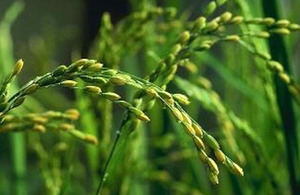DFID Research: Rice growing takes off in Africa
Rice production in Africa is showing impressive gains.

Rice plant. Picture: USDA
Paddy production in Africa has been on the rise for the last 6 years, last year reaching 21.6 million tonnes. With increasing demand for rice in Africa, and the need to provide food security, increased production of rice has been welcomed in Burkina Faso, The Gambia, Guinea, Mali, Niger, Senegal and Togo.
Impressive growth has not been a coincidence. Favourable weather conditions have undoubtedly played their part, but new varieties of rice known as NERICA, introduced by the Africa Rice Centre (WARDA), have been a major factor in this growth. The new varieties which combine Asian and African qualities boast higher yield, a shorter period of growth and resistance to local stresses. With the potential to respond to local demand and food security, they are also 25% higher in protein content than the imported rice varieties sold on the local market.
Better science
Improving upland rice varieties has been a major focus for WARDA, but because Asian rice varieties are often susceptible to African disease and viruses, success has been limited. NERICA varieties have been successful because they combine the positive qualities of Asian rice species Oryza sativa and African O. glaberrima variety. Scientists overcame the main problem with crossing species - hybrid sterility - using conventional and molecular biology techniques, to accelerate the breeding process from up to 7 years, to below 2 years.
Although not directly funding the NERICA initiative, in 2006, DFID provided £500,000 of unrestricted core funding to WARDA. The positive results of NERICA rice have reached many countries in Africa. In Nigeria, the largest importer of rice in Africa, strong measures to reduce rice imports and support domestic rice production using improved varieties, including NERICA, have resulted in reduced imports in 2005 by over 800,000 tonnes, benefiting the local economy. In Burkina Faso, rice production rose by 102% between 2005 and 2006, and in Mali, production increased from 946,000 in 2005 to over 1 million tonnes in 2006.
Overcoming challenges
There are problems that farmers face in adopting the new varieties. One is the availability of seed, and another is accessibility of fertilisers, which NERICA varieties require to meet its maximum potential. But according to farmers the varieties are popular - the potential adoption rate is up to 68%. NERICA varieties have been tested in 31 sub-Sahara African countries, and roughly 200,000 hectares are under upland production. WARDA has developed several hundred NERICA lines, increasing global biodiversity and farmer’s yields.